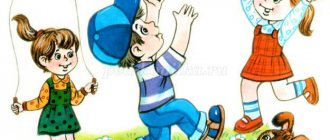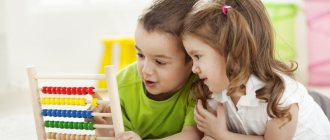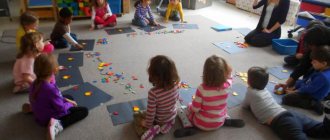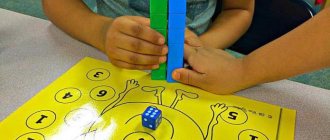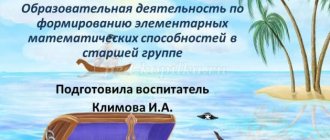Didactic games for mathematical development
The presented card index of didactic games in mathematics is recommended for preschool teachers and parents. During classes, preschoolers become familiar with counting, learn to work with numbers and geometric shapes, compare, contrast, and list.
Objectives of the games presented in the catalog:
- gaining skill in using numbers;
- improving the ability to count and distribute numerical values;
- familiarity with numerical and conceptual designations of time, days, months;
- development of spatial and planar orientation, the ability to determine and explain the location of objects relative to each other;
- expansion of ideas about geometric shapes;
- development of memory, ability to think logically, reason, analyze, make assumptions, sum up, concentrate attention;
- development of creative thinking and imagination.
Middle group. Junior preschool age. Children 4 - 5 years old
Didactic game for developing logical thinking of children 2–4 years old “Magic Hedgehog”
rules for "Magic Hedgehog"
. Age: 2-4 years. Number of players: 1-2 people Equipment: Hedgehog, 5 cones of different colors. Objectives: 1. Development in children of attention, intelligence, logical thinking, the ability to reason and draw conclusions based on reasoning. 2….
The problem of developing geometric concepts in children of primary preschool age using natural materials. At preschool age, children master elementary mathematical concepts associated with set, number, counting, the shape of objects and geometric figures, quantities and their measurement, the simplest calculations that they comprehend empirically, sensory level...
Didactic games in mathematics for the younger group
We present educational mathematical games that younger preschoolers can handle.
Find the figure
The teacher lays out 12 geometric shapes of different sizes and colors on the table in random order. He names an object with certain parameters, for example, a large green triangle, and the student must find this figure on the table and point at it with his finger.
Geometric shapes around
The game expands your understanding of basic geometric objects. For the lesson, you need to prepare images of figures known to preschoolers. The players’ task is to find things in the playing area that are similar in outline to the figures on display.
3 square
The game develops the skill of relating objects by size and consolidates the corresponding definitions in memory.
The teacher prepares 3 stacks of different sized squares. He takes 3 paper figures for himself, and distributes the remaining 3 pieces to the pupils. At the beginning of the game, the teacher one by one shows the squares to the children, while explaining the size of these figures: “This one is large, this one is medium, and this one is small.” Then he gives the commands: “Show me the smallest square. And now the big one. Show me the middle one." The children do it.
At the second stage of the game, the teacher tells that you can build a turret out of squares and shows how to do this. The large square should be at the bottom, the middle one is placed on it, and the small one becomes the top of the head. Pupils repeat after the teacher.
Treat the squirrels and bear cubs
The game teaches you to see whether groups of objects of different sizes are equal. Players develop the understanding that quantity is not determined by size.
The teacher places the toy animals in a row, explains that they supposedly came to visit, and first prepares images of forest treats: nuts for the squirrels, strawberries for the cubs. He asks the children if there are enough treats and asks how to find out. The players count how many toys came to visit and compare the quantities. Next, they give the animals a treat: they place the corresponding images next to them. If the number of treats turned out to be insufficient, children add as many as needed. If there are too many treats, the extra pictures are removed.
Call
The teacher arranges the counting sticks in two columns. One column should be larger in quantity than the other. The rest of the sticks are in the open box. The task is to use additional sticks to equalize the number of objects in the columns. After completing the task, the player must explain how he got this result.
Interactive educational poster “Fun Math”
Ekaterina Kladova
Interactive educational poster “Fun Math”
Goal: to consolidate children’s knowledge of the material covered on FEMP
Tasks:
Educational:
1. Repeat counting within 5, use in speech.
2. To develop children’s ability to distinguish objects by size and designate them with the words high - low, long - short, wide - narrow.
3. To develop children’s ability to distinguish and correctly name geometric shapes and select according to a given characteristic.
Educational:
1. Develop attention, memory, thinking, active vocabulary.
2. Develop finger motor skills.
Educational:
1. Develop an interest in joint activities with adults and peers.
2. To develop the ability to listen and hear the teacher, to act according to the verbal instructions of an adult.
Age: for children of primary preschool age.
The material will be useful:
Teachers of preschool educational institutions
Parents of preschool children.
Long weekends provide an opportunity for children and parents to spend a lot of time together. I would like to bring to your attention an interactive manual for preschool children (middle group)
according to FEMP.
teaching methods are difficult to imagine without multimedia interactive technologies that allow the use of text, graphics, audio, and video. These opportunities significantly expand the scope of application of computer technology in the educational process. Visual and sound accompaniment help to activate the imaginative thinking of children of primary preschool age, which contributes to a more holistic perception of the material and improves the quality of education in the pedagogical process.
The interactive poster is primarily designed to provide a high level of visibility of the educational process. K. D. Ushinsky, revealing the advantages of visual learning , noted that the child “. thinks in forms, colors, sounds"
.
Interactive poster “ Fun math for kids ”
designed for children of primary preschool age (junior group, educational area - cognitive development
(FEMP)
in the Power Point environment and made using the
“single screen”
, which allows you to visually perceive
the poster as one slide, without noticing the transitions between them. This methodological development can be used to review the material or a final lesson on the formation of elementary mathematical concepts ... The poster consists of several slides. The number of slides varies depending on the number of objects presented on the poster plus the title slide and slides with test tasks. The transition between slides is done by clicking on the image of one from objects through hyperlinks. It is possible to end the slide show at any time by clicking on the button at the top. In the poster “
Fun mathematics for kids " , by clicking on the topic we need (geometric shapes, magnitude, counting), we will see tasks for children who they can do it on their own: find an extra object, use the concepts of
“more-less”
,
“longer-shorter”
,
“wider-narrower”
,
“many-one”
.
By following the hyperlink “geometric shapes”
, we will see pictures where we need to find objects similar to geometric shapes.
If children choose the correct answer, the picture becomes transparent, and if the picture is redundant, it disappears. Having followed the hyperlink “magnitude”
and
“counting”
, children use the concepts already familiar to them:
“more-less”
,
“longer-shorter”
,
“wider-narrower”
,
“many-one”
.
They only need to choose one picture. If the last task is answered correctly, the user goes to a slide with topics, after which he can complete the work, or continue interacting with the poster .
Our students enjoy working with interactive aids . Interaction with them arouses keen interest and promotes the development of cognitive activity.
Didactic games in mathematics for the middle group
We present games for middle group kindergarteners, covering a wide range of mathematical knowledge: arithmetic, geometric, logical.
Tell me the missing number
To play you need to prepare 10 cards. Each one depicts a circle with a specific number from 1 to 10. All images are of different colors.
The teacher lays out the cards in the correct sequence of numbers. Children carefully examine the images, making sure that not a single number is missing. Then they close their eyes, and the teacher hides one image. Having opened their eyes, children try to remember what color the circle disappeared, what number was depicted on it.
Count by sound
To play, you need cards depicting objects from 1 to 9. The teacher knocks on the tambourine a certain number of times, the children listen carefully and count the number of hits. Then select a card depicting the corresponding number of objects.
Math riddles
The game develops counting skills. The teacher posts several images of objects made in a certain quantity. Hand out drawn numbers to the children. Next, he reads out a riddle about one of the depicted objects, and the players guess it. For example: “I’m the size of a fist, red side, if you touch it it’s smooth, if you bite it it’s sweet.” Answer: "Apple." Children point to the picture, count how many apples there are on it, and raise the corresponding number.
Geometric designs
To play, you need to prepare images of 3 objects made from different geometric shapes: a house, a tree with Christmas balls, a snowman.
Children carefully look at the images, and the teacher asks questions:
- what figures are the drawings made from?
- are there any triangles here, count them;
- Are there squares, how many are there;
- if there are circles, count them;
- if there are any other figures, what kind and in what quantity;
- how many figures are there in the picture?
- the figures are the same or differ in size;
- what figures are there more?
Let's fix the car
The game requires an image of a car made up of geometric shapes. One of the players becomes the leader, the rest of the children close their eyes. The presenter hides one of the figures that make up the car. Players, opening their eyes, must say what has disappeared. The first player to correctly name the missing part becomes the next leader. The game can be complicated: remove not one, but two pieces.
Find the mistake
The teacher arranges geometric shapes in a row according to certain characteristics. One of the objects does not correspond to the unifying feature. For example, all squares are green and one is blue. Or, in a row among the triangles there is a circle. The player must identify the error.
Magic bag
There are geometric shapes in an opaque linen bag. The player, plunging his hand inside, gropes for the object and names what it is. The game can be complicated: the teacher sets a certain figure, and the child tries to feel it and find it among the others.
Adjacent digits
The players stand in a row. The presenter throws the ball to each child and names a number, for example 5. The task of the player who received the ball is to name the adjacent numbers. In this example it is 4 and 6.
Kaleidoscope of squares
The game reinforces the idea of the relationship between parts and the whole and develops color perception. For the activity you need 36 paper squares 8x8 cm. The figures must be of different colors, and the shades must be clearly distinguishable. The squares need to be cut randomly. Write a number on the back of each piece.
Players complete the following tasks:
- put the pieces together into squares;
- distribute parts of figures by color;
- arrange the pieces according to numbers;
- They try to make squares from pieces that don’t match in color.
Describe the pattern
Each player receives an image consisting of different geometric shapes. The child must carefully examine his pattern and describe it in detail. For example: “There is an oval in the upper right corner, a circle in the upper left, a triangle in the lower right, a circle in the lower left, and a rectangle in the middle.”
Matryoshka dolls
The game develops the skill of ordinal counting. For it you need to take 5 scarves of different colors and put them on the heads of the children standing in a row. The remaining players take turns taking part. The player approaches the nesting dolls, they call themselves: “first”, “second” ... “fifth”. The player remembers what number the nesting dolls with a certain color of scarf are located under, then turns away. Two people in a row change places. The player, turning back, must say what has changed. For example: “The matryoshka doll with a green scarf was second, now it’s fourth. And the nesting doll with a yellow scarf was fourth and became second.”
Do-it-yourself didactic manual for teaching numeracy in kindergarten
Do-it-yourself didactic mathematical manual for preschoolers
Master class on the production of the didactic manual “Fun Counting” for individual work with preschoolers
Author : Natalya Evgenievna Khokhlova Position: teacher-defectologist Place of work: MKDOU No. 22, Miass, Chelyabinsk region Description: master class on the production of the didactic manual “Fun Counting” for individual work with preschoolers on the formation of elementary mathematical concepts. Purpose of the material: for preschool teachers and caring parents. Goal: Production of a didactic manual “Funny Counting” for individual work with preschoolers. Objectives: - learn to create teaching aids with your own hands; - develop creativity. One of the main areas of preschool education is mathematics. “A child’s element is play,” so the main principle is to teach while playing. Teaching mathematics in a playful way develops and shapes the child’s cognitive interest. To make the teaching aid “Merry Counting” we will need materials: White cardboard; Scissors; Glue; Adhesive tape.
And so do the pictures. I made a blank from pictures taken from the Internet and printed them on a color printer. I fit 4 rows of pictures on one A4 sheet. Dimensions of one row: height 4.5 cm, width (length) 28 cm. Each row contains 10 pictures. I will be happy to share my preparations with you. We cut the printed blanks into strips along the lines.
We make the same blanks (strips) from cardboard measuring 4.5 cm * 28 cm). And in addition to each workpiece, we will need two small strips measuring 0.7 cm * 28 cm.
Next, use glue to glue our row of pictures onto the cardboard blank.
If you have a sufficient number of pictures, from magazines, unnecessary books, then you can cut them out and paste them on cardboard, then you don’t need to print the pictures. Next we need a self-adhesive film, which can be of any color. Cut a strip of self-adhesive a little wider than our narrowest strip.
We glue a narrow cardboard strip along the very edge of the self-adhesive, leaving the adhesive part of the film open.
Then we take our wide strip with the picture pasted on it and place it face down, aligning the edges of the narrow and wide strips, also leaving the adhesive edge of the film open.
After the edges of the strips are aligned, we bend the adhesive edge of the film, thereby gluing the narrow and wide strips, turn it over and see what we got.
We process the second edge of the wide strip in the same way. Next, we cover with self-adhesive film the edge of the wide strip where the counting of objects will begin.
Cut a small strip of cardboard or any paper. Size height 4.5 cm, width 0.7 cm.
We put this strip under our sides
And glue a strip of self-adhesive film of the same size on top.
This needs to be done in such a way that we can insert a “slide” strip on this side of the card. Now our card does not look very aesthetically pleasing due to the fact that the narrow strips along the edge of the card do not fit tightly to the base and are puffy. All this can be corrected after all the cards are ready by placing them under a press.
Next, cut out the “engine” strip from the cardboard. It should be a couple of millimeters smaller in height than the manufactured card, and a couple of centimeters longer in length.
We insert the “engine” strip into the manufactured card and the card is completely ready.
I use the didactic manual “Fun Counting”, made with my own hands, in individual work with children on the formation of elementary mathematical concepts, such as quantity and counting. This manual helps solve the following problems: - consolidate quantitative and ordinal counting; - exercise children in counting objects; — secure direct and reverse counting; When working in a compensatory kindergarten, great attention has to be paid not only to the development of mental processes, but also to the development of speech. That’s why I try to select multifunctional aids. Also, working with this manual helps children learn to coordinate numerals with nouns in gender, number, case, and enrich their speech with nouns and adjectives. For example: one pan, two pans, three pans, four pans, five pans;
Or the use of the words one-one-one, two-two; One apple – two apples, etc.; You can count using an adjective - one green apple, etc.
Cards can be made using pictures corresponding to the lexical topic of the week.
If desired, you can make the required number of cards to work with the subgroup. I hope that this teaching aid will be a good help to you and your children. I wish you creative success!
We recommend watching:
Do-it-yourself multifunctional game aid for preschoolers Do-it-yourself didactic aid for younger preschoolers Do-it-yourself didactic aid for kindergarten Do-it-yourself didactic aid “Paired Pictures” for kindergarten
Similar articles:
Game layout for children 4-7 years old “My City”
Multifunctional teaching aid for children 5-6-7 years old
Do-it-yourself manual for developing fine motor skills
Didactic games in mathematics for the senior group
We present educational games suitable for the older age group of kindergarten.
Aircraft
The game introduces the composition of the number 10. The flannelgraph acts as an airfield. Images of airplanes are attached to it. One of the students becomes a dispatcher: he sends one plane at a time and removes the flannelgraph. The rest of the players count how many planes have flown away and how many remain at the airfield.
Fun geometry
To play you need counting sticks. Children fold them so that geometric shapes emerge:
- 3 identical squares of 10 sticks;
- 2 identical squares out of 7;
- 2 identical triangles out of 5;
- 3 identical triangles out of 7;
- 4 identical triangles out of 9;
- one square and 2 identical triangles out of 5;
- one square and 4 triangles out of 9;
- 2 squares and 4 identical triangles out of 9.
In the last task you need to make squares from 7 sticks, then use the remaining 2 sticks to break them into triangles.
What happens?
The purpose of the didactic game in mathematics is to develop ideas about basic subject quantities and develop the skill of determining similarities in size.
The teacher names an adjective that defines a quantity, throws the ball to the players one by one, and they must name the objects that correspond to the specified definition. For example: "Tall". Children list: “Giraffe, closet, house, man, mountain.” Similarly for other definitions: long, narrow, short, low, large, small, wide.
Months
To play, you need cards depicting numbers from 1 to 12. Children sort the cards without looking. Then they stand in a row according to the numbers received. The teacher says that now the children have become the 12 months of the year. Then he asks questions of this type: “Third month, what is your name? April, what number are you?”
At the second stage of the game, the teacher lays out pictures on the table depicting seasonal landscapes and phenomena corresponding to the months. Players look at the pictures and find an image that matches their month.
Count by touch
To play, you need cardboard strips with beads sewn to them in quantities from 2 to 10. Players stand in a row, put their hands behind their backs, and receive strips from the teacher. Hands remain behind your back; you cannot look at the stripes. The game task is to count the number of beads.
The teacher names an arbitrary number, for example, 3. The child, who has counted the same number of beads, raises his hand and shows everyone the strip. Then the teacher changes the players' stripes and the game continues.
When does this happen?
The game reinforces the idea of the time periods of the day, what one should do at different times. For the lesson, you need to prepare a large image of a clock with a moving hand, as well as pictures that show what people are doing at different times of the day. The teacher moves the arrow for a certain time, and the children choose the corresponding picture. For example, when the hand is moved to the hour, children choose a picture of a family having dinner.
Compare tapes
The game trains the skill of comparison based on external parameters. For this lesson you need 7 ribbons, varying in width and length.
Having laid out the tapes, the teacher asks the children:
- how many ribbons are there;
- are they the same or different;
- which ribbon is the longest, shortest, narrowest, widest;
- arrange the ribbons, starting from the shortest, ending with the longest;
- where in the resulting row is the widest ribbon, and where is the narrowest;
- arrange the ribbons from narrowest to widest;
- where in the resulting row is the longest ribbon, and where is the shortest.
Count the sounds of the orchestra
To play, you need musical instruments familiar to preschoolers that you can knock on: a drum, a tambourine, a triangle, a toy synthesizer. First, the teacher demonstrates to the students how the instruments sound, then hides them behind a screen. There, the teacher again hits a certain instrument 2-5 times, and the children must say what it sounded like and how many hits they heard. The game can be made more difficult by hitting 2-4 instruments at a time.
Let's treat ourselves to fruit
The game teaches division into different-sized parts and expands thematic vocabulary. The teacher brings fruit, for example peaches. He complains that there is not enough food for everyone. He asks what to do so that everyone gets a piece of peach. Children advise: “Divide.” Next they explain how fruit is divided: “In half.” The teacher cuts the peaches. But there is still not enough food for everyone. Then the children advise: “You need to divide each half into two parts. It will turn out to be quarters.” Now everyone has enough food.
Didactic games in mathematics in the preparatory group
The preparatory group prepares preschoolers for entering school. Children already have a lot of knowledge, so games become more complex and provide the development of mathematical concepts sufficient for trouble-free learning in primary school.
Decorating the Christmas tree
The teacher attaches to the flannelgraph and also distributes to the pupils images of a Christmas tree and New Year's balls. He attaches 4 toys to the Christmas tree on the right side, 2 on the left. Children do the same with their Christmas trees. The teacher suggests adding up the balls: 4 + 2 = 6. Then he swaps the balls, it turns out 2 + 4 = 6. And so on several times with different numbers of toys. The game creates the idea that changing the terms does not change the sum.
Path for Little Red Riding Hood
Attached to the flannelgraph are images of grandma's house, Little Red Riding Hood, and forest trees. Under each tree is a simple arithmetic example that a preschooler can handle. The students take turns approaching the flannelgraph, solving an example, thereby moving Little Red Riding Hood closer to grandma’s house.
Yes or no
The teacher writes arithmetic examples on the board. Then shows the children pictures of numbers. If the number matches the solution to the next example, the children shout out: “Yes!” If the answer is wrong, they shout: “No!”
Make up a word
The game is competitive. The teacher displays arithmetic examples in two columns. Members of each team go out to solve them. The player who has solved the example approaches the table on which there are pictures of numbers corresponding to the solutions. He chooses his number, turns the picture over, and there is a letter there. Having solved all the examples, the team gets the floor. Those who complete the task faster win.
Do-it-yourself didactic math games
To enhance the cognitive interest of preschoolers, it is recommended to create bright, varied and exciting material for games. It’s not difficult to make math games with your own hands, here are some interesting examples:
- Apples cut out of paper with different numbers of seeds - from 1 to 10. Children attach cards to them with the corresponding image of the numbers.
- Mathematical rosary - a cord with stringed beads. When solving an arithmetic example, the child moves the beads: counts the first number, then the second. And then he adds or subtracts and determines the resulting number of beads.
- Continue the series. The paper strips have different curved lines on them. At the beginning, geometric figures are glued along these strips in a certain sequence. The child’s task is to continue the row using additional figures from the box.
- Catch a fish. The paper buckets show numbers from 1 to 10. The fish show arithmetic examples. The preschooler solves the example, looks at which bucket shows the answer, and places the fish there.
- Cardboard sheets of a certain color have several different geometric holes cut into them. Geometric shapes are also cut out to match these holes in the shape and color of the sheet. The game task is to correctly place the pieces in the holes.
When making materials for games, you can use any available and natural means. The main thing is that they must be harmless to the child.
